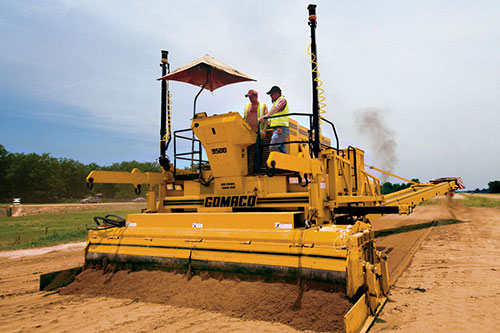GOMACO World Index --- GOMACO World 36.3 - December 2008
Stringless Trimming Production on a Bypass Project in Arkansas
The town of Grady, Arkansas, had to be bypassed this summer when it didn’t have enough room through its downtown area to accommodate the Highway 65 rebuilding project. The Arkansas Highway Department purchased new right-away land for the project and work on the new bypass began.
The new four-lane roadway, two lanes each, going northbound and southbound, was created for the project. Weaver Bailey Contractors Inc., based out of El Paso, Arkansas, was responsible for trimming the subgrade. They brought in their two GOMACO 9500 trimmers for the work.
One 9500 ran off stringline, while the other trimmed with the company’s new Topcon Millimeter GPSTM 3-D machine control system.
“We thought it was time to take a step forward with the stringless technology and see what advantages the GPS system on one of our trimmers would have for us,” Jim Jolly, General Superintendent for Weaver Bailey, said. “We were very paranoid starting out with it, because we’ve been on string for so many years.”
The 9500s are equipped with 16 foot (4.9 m) trimming heads and are cutting through a silty sand material. Five different passes were needed to accomplish the trimming for the 60 foot (18.3 m) wide subgrade.
Stringline was set on some of the trimming passes for one of the 9500s. The stringline also served as a check for the stringless system to make sure it was cutting an accurate subgrade. It was a measure taken to combat some of the company’s stringless paranoia.
“We had the stringline to come back to and check grade at any given spot,” Jolly said. “Plus, we had a Topcon rover for other spot checks so we knew, without a doubt between the two methods, that we were hitting grade.”
With any doubts about the system’s accuracy erased, Weaver Bailey started focusing on production. The 9500 with stringless was averaging 5000 square yards (4181 m2) of trimmed material per day. The 9500 on string averaged around 3000 square yards (2508 m2).
“There’s the tendency with the stringline system that the faster you go, the more vibration you pick up in your stringline and sensor wands,” Jolly said. “You don’t have to worry about that when you’re stringless, and you can trim at a higher speed. We can probably trim one-third faster than with stringline and not have any trouble with the grade, if our subgrade out front is prepared fairly closely.”
Time savings also have to be taken into consideration with the stringless system. Crews aren’t needed to set up all of the stringline on the project. Jolly also mentioned time savings with the 9500 itself, getting off and on stringline for each trimming pass.
“The trimmer has to be set up and ready to run for every pass on the stringline... extend the arms out, reset the trimmer, get back on line, that sort of thing,” Jolly explained. “A really experienced crew will probably spend about 30 minutes getting the trimmer ready to go again for another pass. With the stringless, you just pull off the trimmed pass, set down on the new one and go again. That’s a big time savings for us.”
Weaver Bailey has claimed success on their first stringless trimming project and are already looking forward to another to put their 9500 trimmers to work on.
“Our 9500s are really good machines,” Jolly said. “One of them is almost 15 years with 15,000 hours on it and it’s still running good. We’re not afraid to work them hard and they never fail to deliver a good product.”
Subscribe to Receive GOMACO World Magazine
